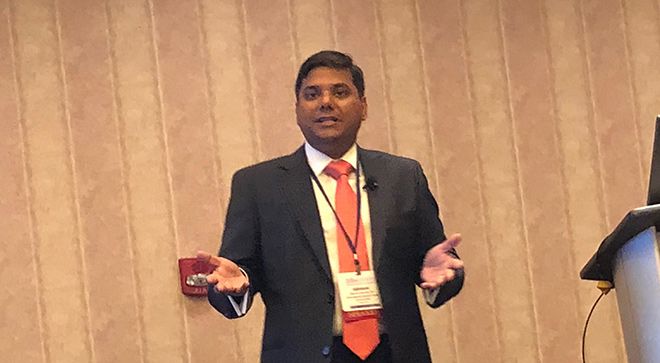Utilizing a Multidisciplinary Approach in Multiple Myeloma Assessment and Treatment
Treatment for multiple myeloma is quickly evolving. To bring physicians, nurses, and other members of the community oncology care team up to date, Abhinav B. Chandra, MD, MSc, FACP, conducted a presentation at the Association of Community Cancer Centers (ACCC) 35th National Oncology Conference in Phoenix, Arizona.

Abhinav B. Chandra, MD, MSc, FACP, medical director, Yuma Regional Medical Center Cancer Center, spoke at the Association of Community Cancer Centers 35th National Oncology Conference about current treatments for multiple myeloma.
Treatment for multiple myeloma is quickly evolving. The wave of recent trial developments and therapy approvals can make it difficult for clinicians to keep current, especially in smaller community cancer centers where cases of this rare hematologic cancer—myeloma represents 2% of new cancer cases in the US1—may be rarer still, and may not be a priority.
However, the exciting therapeutic developments in myeloma treatment and their long-lasting survival benefits are pushing the disease to the forefront of targeted therapy news.
To bring physicians, nurses, and other members of the community oncology care team up to date, Abhinav B. Chandra, MD, MSc, FACP, medical director, Yuma Regional Medical Center Cancer Center, conducted a presentation at the Association of Community Cancer Centers (ACCC) 35th National Oncology Conference in Phoenix, Arizona.2
Transplant Eligibility
Chandra explained how to evaluate a newly-diagnosed patient using the International Myeloma Working Group risk stratifications. When evaluating a patient, one of the first things to do is to establish if the patient is transplant-eligible, he said.
“Age is not a factor in whether you are transplant-eligible or not,” he explained. “We always look at the whole picture. We look at what the patient’s social support is. We factor in a lot of things before we (decide) about transplant eligibility.”
If a patient is transplant-eligible, the care team should plan for the transplant between 4 to 6 cycles of chemotherapy.
“Early referral is key,” Chandra said. “As soon as you are going into the second cycle, you have to make the referral. Sometimes insurance issues may be a barrier, so you want to make sure you refer the patients early. And generally, working with the transplant team, you need to have good coordination.”
Skeletal-Related Events
Chandra noted that patients should be monitored carefully for severe skeletal-related events (SREs) such as spinal cord compression or vertebral compression fractures, which could require surgery to prevent permanent paralysis. Many patients with multiple myeloma have bony lesions that are often treated with either zoledronic acid or denosumab. These treatments have the potential to cause osteoporosis of the jaw. Therefore, Chandra urged clinicians to consult the 2018 ASCO Clinical Practice Guideline Update: Role of Bone-Modifying Agents in Multiple Myeloma.
Role of Immunotherapy
Two studies presented at the 2018 ASCO Annual Meeting tested immunotherapies in multiple myeloma: KEYNOTE-183, which evaluated pembrolizumab (Keytruda) in combination with pomalidomide (Pomalyst) and low-dose dexamethasone in refractory or relapsed and refractory multiple myeloma, and KEYNOTE-185, which investigated pembrolizumab in combination with lenalidomide and low-dose dexamethasone in newly diagnosed and treatment-naive patients.
“Both studies had very similar outcomes,” Chandra said. “It was found that adding (pembrolizumab) increased severe adverse events (AEs), and there was no increased efficacy when combined with (an immunomodulatory imide drug) and dexamethasone. So, as of now, immunotherapy with pembro or nivolumab will not be evaluated much in multiple myeloma.”
CAR T-Cell Therapy
“There is always a lot of excitement around CAR T-cell therapy,” said Chandra.
In a trial in which patients with relapsed or refractory multiple myeloma received the novel agent bb2121, a second-generation CAR T-cell therapy targeting B-cell maturation antigen.
“The overall response rate was very impressive,” Chandra said.
The small test group (between 20 and 30 patients) achieved an objective response rate of 95.5%, with patients achieving minimal residual disease, and progression-free survival of about 11.8 months.
“These are patients who have relapsed/refractory myeloma who have been treated on 4, 5, (or) 6 lines of therapy, so to see this kind of was definitely activating,” he said.
Lastly, about 63% of patients experienced cytokine release syndrome, a common AE related to CAR T-cell therapy.
The Bigger Picture
Chandra’s presentation was one part of a programmatic effort by the ACCC and the Multiple Myeloma Research Foundation (MMRF) to expand the oncology community’s understanding of multiple myeloma treatment. It was the third in a series of lectured developed as part of the ACCC’s Multidisciplinary Myeloma Care education project.1
In addition to the lectures, an expert advisory board comprised of clinical team members, social workers, and patient advocates created an online resource and a publication aimed at supporting the care team in diagnosing, testing, and treating patients with multiple myeloma.
References
Multidisciplinary multiple myeloma care. ACCC website. accc-cancer.org/projects/multidisciplinary-multiple-myeloma-care/overview. Accessed Oct. 14, 2018.
- Chandra AB. Leveraging a multidisciplinary approach to multiple myeloma care. Presented at: Association of Community Cancer Center 2018 National Oncology Conference; October 17-19; Phoenix, AZ.
Shared Model of Care Post-HCT Offers Safe Follow-Up, Reduces Patient Burden
Published: March 19th 2025 | Updated: March 19th 2025Alternating post-HCT care between specialized facilities and local cancer centers produced noninferior non-relapse mortality and similar quality of life to usual care.


